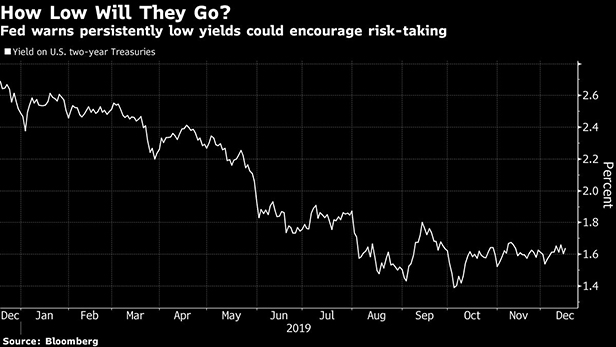The Federal Reserve is running the risk of fomenting an eventualfinancial crisis by easing banking regulations at the same timethat it's cut interest rates.
|So say some former Fed officials, including ex-Vice ChairmanAlan Blinder and financial stability experts Daniel Tarullo andNellie Liang. They worry that the combination of looser credit andlaxer rules will prompt financial institutions and investors topile on leverage and take excessive risks. While that may spureconomic growth in the short run, it could end up triggering arecession once the speculative bets are unwound.
|"When you lower rates and put incentives in place to increaseborrowing, it should not be surprising that risks will increase,"said Liang, former director of the Fed's financial stabilitydivision. "That means this is not the right time to be alsosignificantly loosening financial regulations."
|U.S. stocks have risen to record levels and junk-bond yieldshave sunk to five-year lows this week on hopes that a partial U.S.-China trade deal will boost globalgrowth already buttressed by easier credit. After lowering ratesthree times, Fed policymakers left them unchanged on December 11and forecast they would stay that way through the2020 presidential election year. The central bank has also made orproposed various changes in financial oversight, includingalterations to the stress tests that banks undergo and an overhaul of theVolcker Rule's trading restrictions.
|Republican lawmakers and banks have complained that theFed has not gone far enough in easing rules, while Democrats suchas presidential candidate Elizabeth Warren have warned the centralbank against loosening its regulatory grip.
|Liang, who was nominated by President Donald Trump to the Fedboard but withdrew her name after opposition from some lawmakers,voiced concern about mushrooming corporate credit. "I worry thatdefaults and investor losses will be higher than expected in thenext downturn and will make the next recession more severe," shesaid.
|
In its latest financial stabilityreport, the Fed's board said a prolonged period of low ratescould undermine financial stability by prompting profit-pinchedbanks and other firms to take more risks. However, Fed leadershipthough has pushed back hard against suggestions it has made thefinancial system more vulnerable by loosening regulations, arguingthat the capital requirements of the biggest banks remain as toughas ever.
|The U.S. has "a stable, healthy, and resilient banking sector,"Randal Quarles, Fed vice chairman for supervision, told lawmakers onDecember 4. He said that the Fed's focus has been on tailoring theregulation of regional and smaller lenders. "One of our principleshas been to ensure that we do not reduce, in any material way, theloss-absorbing cushion of the institutions," he said "I think wehave succeeded in doing that."
|Former Fed Governor Tarullo is not so sure. He zeroed in on thestress tests, including the disclosure of more information aboutthe models behind them. "I suspect quite strongly that theeffective amount of capital the banks have to have for a givenportfolio is lower because they have so much more information aboutthe stress tests," said Tarullo, who was the Fed's point man onregulation after the 2008 crisis and is now at the Harvard LawSchool.
|Ex-central bank Vice Chairman Donald Kohn welcomed efforts totailor rules to fit the size of the institution but cautionedregulators against taking their eye off of "very sizable" regionalbanks. "You get a bunch of regional banks all doing the same thingat the same time, then that could be systemic," said Kohn, a memberof the Bank of England's Financial Policy Committee. There's also"reason to be cautious about what's going on outside the bankingsystem when you lower rates because you have fewer macro-prudentialtools to deal with that sector," he said.
||
Changing Incentives Through Policy
Under the Dodd-Frank Act, the sweeping post-crisis regulatoryreforms introduced to strengthen the banks, the Financial StabilityOversight Council (FSOC) monitors the overall financial system.Headed by Treasury Secretary Steven Mnuchin, it has the power todesignate non-bank financial institutions such as insurancecompanies as "systemically important," and so subject them toincreased regulation.
|The council, whichincludes the heads of the Fed, the Securities and ExchangeCommission (SEC), and other regulatory agencies, has recentlyshifted its focus toward monitoring potentially risky financialactivities and raised its hurdle for singling out individual firmsfor more supervision.
|"They come very close to saying that they're never going todesignate a non-bank, no matter what," Tarullo said. "That almostdefies the will of Congress." He also voiced doubts that thecouncil has the authority or the desire to impose more regulationon financial activities.
|Blinder said Trump appointees at other regulatory agencies weremore to blame for what he called "backsliding." The Fed though isnot immune and shouldn't be easing credit and bank rulessimultaneously. "You can try to push up aggregate demand and expandthe economy with lower interest rates, but don't drop yourregulatory safeguards" as well, the Princeton University professorsaid.
|Some current Fed policymakers share the concerns of their formercolleagues. Fed Governor Lael Brainard has voted against some ofthe board's rule changes, while Boston Fed President Eric Rosenberghas called for higher bank capital in today's low interest rateenvironment.
|Liang, who is friend of Powell's, said she agrees with him thatfinancial stability risks aren't elevated currently. "If you took asnapshot of the situation now, it looks OK," the BrookingsInstitution fellow said. "But I worry about what the situationwould look like in a year or two given the incentives from recentpolicy changes."
||
Copyright 2019 Bloomberg. All rightsreserved. This material may not be published, broadcast, rewritten,or redistributed.
Complete your profile to continue reading and get FREE access to Treasury & Risk, part of your ALM digital membership.
Your access to unlimited Treasury & Risk content isn’t changing.
Once you are an ALM digital member, you’ll receive:
- Critical Treasury & Risk information including in-depth analysis of treasury and finance best practices, case studies with corporate innovators, informative newsletters, educational webcasts and videos, and resources from industry leaders.
- Exclusive discounts on ALM and Treasury & Risk events.
- Access to other award-winning ALM websites including PropertyCasualty360.com and Law.com.
*May exclude premium content
Already have an account? Sign In
© 2024 ALM Global, LLC, All Rights Reserved. Request academic re-use from www.copyright.com. All other uses, submit a request to [email protected]. For more information visit Asset & Logo Licensing.








